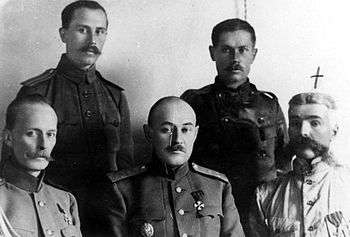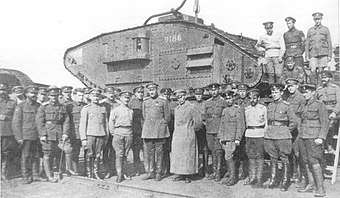Don Army
The Don Army (Russian: Донская армия, Donskaya Armiya) was the military of the short lived Don Republic and a part of the White movement in the Russian Civil War. It operated from 1918 to 1920, in the Don region and centered in the town of Novocherkassk.
| Don Army | |
|---|---|
| Донская армия | |
 Don Army insignia | |
| Active | 3 April 1918 – 24 March 1920 |
| Country | |
| Allegiance | |
| Branch | Armed Forces of South Russia |
| Size | 17,000 (May 1918) 52,500 (October 1919) 38,000 (February 1920) |
| Engagements | Russian Civil War
|
History

After the October Revolution in 1917, a conflict in the Don broke out between the "Red" Bolsheviks and "White" Don Cossacks.
In Novocherkassk, an assembly of Cossacks, the Krug, elected Alexei Kaledin as the first independent ataman since the days of Peter the Great. They refused to recognise the Bolshevik government and declared themselves protectors of Russia.
On December 2 (old style calendar), Kaledin's Cossacks seized Rostov-on-Don, driving out the Bolshevik authorities and setting up a government headed by Mitrofan Petrovich Bogayevsky.
The Bolshevik resistance, centered in the Kamenskaya stanitsa, was joined by an army sent by Moscow.
Kaledin, feeling powerless to oppose the Bolsheviks, shot himself on January 29, 1918. He was replaced by major-general Anatoly Mikhailovich Nazarov. Nazarov requested help from the Volunteer Army, but was refused it. His resignation was turned down by the krug, who insisted that he fulfill his duty as a 'true son of the Quiet Don'.[1] He decided to end the civil war by capitulating to the Bolsheviks and met with the Red representative, Sablin. Sablin refused to recognise the authority of the Ataman and declared that the Cossacks should be destroyed. In the evening of February 1918, a detachment of the Red Army, under Lt. N. M. Golubov, broke up a meeting of the krug, arresting Nazarov and the chairman, Voloshinov. They were shot without trial on March 3. A policy of Red Terror was carried out along the Don.
Several stanitsas revolted and on April 3, 1918 formed a new Don Army, during the Steppe March. Many Don Cossacks also participated in Kornilov's infamous Ice March from February to May 1918.
On May 12, 1918, a special krug (the krug for the salvation of the Don) declared the old rights and uniforms restored and declared war upon the Bolsheviks. Pyotr Krasnov, a talented soldier and writer, was elected as the new Ataman.
In the Summer and Fall of 1918, the White Don Army controlled the Don territory, severed Red Army communications between Moscow and the Caucasus (allowing the White Volunteer Army to defeat the Red Army of the Northern Caucasus) and threatened Red Army positions at Tsaritsyn and Voronezh, as well as Rostov-na-Donu.
Much of the Upper Don region, in 1918, had defected to the Bolsheviks, but as a result of the Red Terror, in 1919, rose up in arms against them, in what was known as the Veshenskaya Uprising. The main leaders were Pavel Nazarovich Kudinov and Kharlampii Yermakov. They joined forces with the Don Army centered in Novocherkassk, which was commanded by Ataman Afrikan Bogayevsky. These events form an important part of Mikhail Sholokhov's epic, And Quiet Flows the Don. Indeed, for a long time, Kudinov and Yermakov, who appear in the novel, were considered as fictional by the general public.
In the Winter of 1918-1919, the Red Southern Front, including their Group Kozhevnikov, 8th Army, 9th Army, and 10th Army, counterattacked the Don Army and regained control of the area northeast of the Donets and Manych rivers.
The Don army was often divided and plagued with indecisiveness, many of the Cossacks not wishing to fight beyond their own territory.
On January 8, 1919, the Armed Forces of South Russia or VSYuR were created, and the Don Army made an agreement to be subordinates of commander Anton Denikin.
During the heavy fighting in the autumn and winter of 1919, the Don Army suffered significant losses. By January and February 1920, it was defeated in the North Caucasus. Its remnants surrendered in March and April to the Red Army and partly went into their ranks.
On March 24, 1920, Don Army units were transported from Novorossiysk to the Crimea. From there, a Separate Don Corps was formed, and on May 1 all the Don units were consolidated into the Don Corps.
Commanders
- General-major K. S. Poliakov (3 − 12 April 1918),
- General-major Pyotr Popov (12 April − 5 May 1918),
- Lieutenant-general Svyatoslav Denisov (5 May 1918 − 2 February 1919),
- Lieutenant-general Vladimir Sidorin (2 February 1919 − 14 March 1920).
Chief of Staff
- Colonel Svyatoslav Denisov (3 − 12 April 1918),
- Colonel Vladimir Sidorin (12 April − 5 May 1918),
- Colonel Ivan Poliakov (5 May 1918 − 2 February 1919),
- Lieutenant-general Anatoliy Keltchevski (2 February 1919 − 14 March 1920),
- General-major Nikolai Alekseyev (23 April 1920 − December 1920).
Combat strength
Generally after Dobrynin, The Participation of the Don Cossacks in the Fight against Bolshevism.


| Date | Soldiers | Field Guns | Machine Guns |
|---|---|---|---|
| May 1, 1918 | 17,000 | 21 | 58 |
| June 1, 1918 | 40,000 | 56 | 179 |
| July 1, 1918 | 49,000 | 92 | 272 |
| July 15, 1918 | 39,000 | 93 | 270 |
| August 1, 1918 | 31,000 | 79 | 267 |
| November 20, 1918 | 49,500 | 153 | 581 |
| February 1, 1919 | 38,000 | 168 | 491 |
| February 15, 1919 | 15,000 | N/A | N/A |
| April 21, 1919 | 15,000 | 108 | 441 |
| May 10, 1919 | 15,000 | 131 | 531 |
| June 16, 1919 | 40,000 | N/A | N/A |
| July 15, 1919 | 43,000 | 177 | 793 |
| August 1, 1919 | 30,000 | 161 | 655 |
| September 1, 1919 | 39,500 | 175 | 724 |
| October 1, 1919 | 46,500 | 192 | 939 |
| October 15, 1919 | 52,500 | 196 | 765 |
| November 1, 1919 | 37,000 | 207 | 798 |
| December 1, 1919 | 22,000 | 143 | 535 |
| January 1, 1920 | 39,000 | 200 | 860 |
| January 22, 1920 | 39,000 | 243 | 856 |
| February 1, 1920 | 38,000 | 158 | 687 |
In literature
The events of those years, especially those centered in the Upper Don, as well as events leading up to them, are the focus of Mikhail Sholokhov's epic, And Quiet Flows the Don.
See also
References
- Astapenko, pg. 574
- "Istoriya Donskogo Kazachestva; s drevnejshikh vremyon do 1920" (The history of the Don Cossack Host; from ancient times until 1920) M. P. Astapenko.